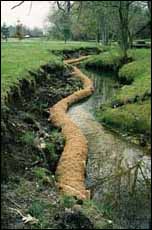Streambank Stabilized Using Natural Bioengineering Solutionsby Murray McHugh |
 Rowan College of Glassboro, NJ, began a streambank stabilization project the spring of 1995 on a limited budget using in-house labor and natural bioengineering solutions. The project has proven to be an overwhelming success by weathering heavy storms over the summers of 1995 and 1996. The design process began with the USDA Natural Resource Conservation Service (NRCS) and was completed by the Gloucester County Planning Department (GCPD). The plan, originally completed by NRCS engineers, was primarily structural with a large amount of grouted rip-rap. As the plan circulated within NRCS, many of the structural solutions were replaced with bioengineering solutions. Chris Miller, the Plant Materials Specialist at NRCS, played the primary role in the initial "softening" of the design. Scott Hall of GCPD worked on the site specific details and also played a major role in the installation of the design. Don Knezick, president of Pinelands Nursery, acted as the primary bioengineering consultant for both the planning and installation of the vegetative measures. A "partnership" between public agencies and the college made the project economically feasible. The USEPA and New Jersey Department of Environmental Protection provided funding through Gloucester County Board of Chosen Freeholders, and Rowan College supplied the majority of the labor. The stream, as it runs through Rowan College campus, has an average width of 5 feet and varies in depth between a few inches and four feet. The channel averages 15 feet wide with 6 foot banks. During storm events, the stream flow often exceeds the capacity of the stream corridor. The increased flow from natural seepage and stormwater runoff was cutting into the banks, causing major erosion that would have soon led to structural damage on the campus. The cuts ranged up to five vertical feet. The materials used included 360 linear feet of BonTerra BioLogs, 525 square yards of BonTerra CS2 erosion control blankets, 390 linear feet of 6-inch diameter wattles, and 1,390 two-inch herbaceous plugs. The logs were 12 inches in diameter, constructed with "loose" coconut fiber packed into a coir fiber netting. They weighed 5 pounds per linear foot and were relatively easy to plug with the plants. The blanket contained a blend of coconut fiber and straw held with nylon netting on both sides of the blanket. The wattles consisted of young woody cuttings of Salix discolor, S. nigra and Cornus Stolinifera, tied together with two-ply sisal. The project was designed specifically to be cost and labor effective. The more costly structural solutions were limited to the areas around drainage pipes and the two bridges within the project area. All of the areas with any degree of bank cutting received BioLogs, and in areas with severe cutting at the stream level, two were stacked, one on top of the other. They were half submerged in the stream and secured with oak stakes through the coir netting, then planted with the plugs. In certain areas, live willow stakes were positioned behind the logs. At these sites with substantial cuts, the areas were graded, seeded and covered with the CS2 mat. In one area with severe vertical cuts, the wattles were used in conjunction with the blankets. Shallow trenches were dug parallel to the stream at four to six foot intervals up the bank. The blankets were placed down and the wattles were laid on the blankets in the trenches and filled with a small amount of soil. A wildflower seed mix was sewn under and over the CS2 blankets in areas which provided a nice aesthetic effect. The project has proven to be an overall success. The region experienced climactic extremes of fifty year storms and record droughts since installation. The erosion control materials stayed in place and curtailed additional bank erosion. Plants have survived both the storms and drought. The plants plugged in the logs survived being bent horizontally by the flooding currents but there was differential growth between the plugs in the sun and shade. The plants shaded by trees showed little or no top growth from the installation date. It has yet to be seen whether the shaded plants will fulfill their bioengineering role of rooting through the logs. The wattles successfully sprouted and the growth has been excellent between the logs, but less than expected up the bank. The wildflowers produced attractive blooms for the majority of the summer and reseeding in the future has been discussed. One trouble spot is on a section of shaded bank that is subject to heavy seepage and subsequent sloughing. The installed CS2 blanket was torn and there was poor germination of the grass seed. A woven coir yarn geotextile mat, with a high sheer strength, would have secured the bank against the sloughing and held the topsoil to permit germination. Correctly applying small details of the installation could have meant the difference between success and failure, but the college in-house crew was eager to learn and master the bioengineering aspects of the project. Frank Pilitowski and Jeff Riggins of the Rowan College Facilities Department were the regulars on the installation. They are continuing to work on other areas of the stream which need attention. Both said that the bioengineering was a nice change from their regular work regime and a relatively easy science to learn. The bioengineering aspects of the project are holding very well and are being watched closely by Frank and Jeff, as they have taken a personal interest in the project. Mr. Pilitowski said, "...every time it rains, we run out there to see what is happening. The bioengineering parts of the project are holding very well and we feel confident that if anything does go wrong, we have the knowledge to repair it." |
©2004 - 1998 Land and Water, Inc.